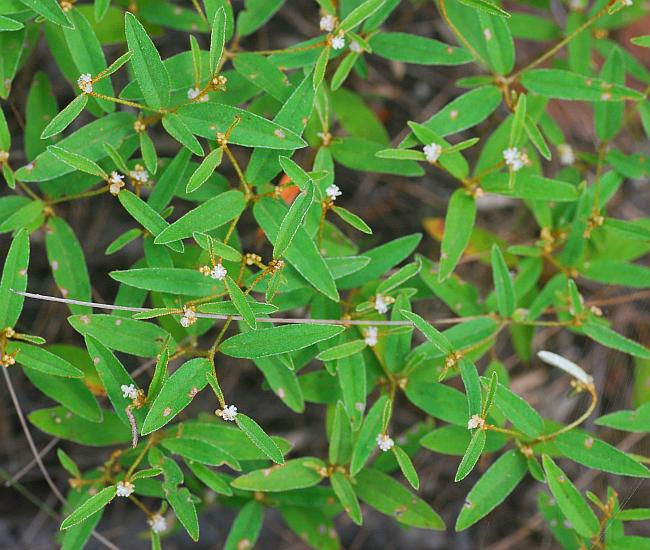Croton willdenowii G.L. Webster
Common Rushfoil

Native
CC = 4
CW = 5
MOC = 54
© SRTurner
Croton willdenowii G.L. WebsterCommon Rushfoil | |
 |
Native CC = 4 CW = 5 MOC = 54 |
© SRTurner |
|
Family - Euphorbiaceae Habit - Taprooted annual forb, monoecious, with clear sap. Plants pubescent with small, peltate, scalelike trichomes (except on the upper surface of the leaf blades), these with a small, raised, brown attachment point and a relatively broad, thin, white body, the slender, stellate extensions forming a minute fringe around the margins, this appressed and not appearing fuzzy. Stems - Ascending, single or multiple from base, often with alternate spreading branches, to 40 cm, lepidote-scaly as described above.
Leaves - Alternate, simple, sessile or short-petiolate. Petioles to 2 mm long, scaly. Blades 0.7-2.0 cm long, linear to narrowly ovate, angled or short-tapered at the base, rounded to angled or short-tapered to a usually sharply pointed tip, the margins entire, the upper surface green, with relatively dense, small, overlapping, stellate hairs, the undersurface densely lepidote and paler than the upper surface.
Inflorescence - Short, axillary, loose spikes with 1 or 2 pistillate flowers at the base and several staminate flowers toward the tip.
Flowers - Staminate flowers with the calyx deeply 4-5-lobed, 0.8-1.1 mm long; the petals 4-5, 0.6-1.0 mm long, white; the stamens 4-6. Filaments white, 1.5 mm long, glabrous. Anthers white, 0.4 mm broad. Pistillate flowers with the calyx 0.8-1.1 mm long at flowering, becoming very slightly enlarged at fruiting, 5-lobed; the petals absent; the ovary ovoid, stellate-pubescent, 1-locular, the 3 styles shallowly 2-lobed toward the tip.
Fruits - Capsules 2.5-3.0 mm in length and diameter, elliptic to oblong-ovate in outline, slightly flattened, 1-seeded, indehiscent, thin-walled, lepidote. Seeds 2.5-3.0 mm long, elliptic to oblong-ovate in outline, slightly flattened, lacking a caruncle.
Flowering - May - September. Habitat - Glades, ledges and tops of bluffs, dry forest openings, fields; usually in nutrient-poor acidic soils. Origin - Native to the U.S. Lookalikes - C. michauxii, C. monanthogynus. Other info. - This is a typical glade species in Missouri. It is found predominantly in counties south of the Missouri River, and also scattered throughout the southeastern quadrant of the continental U.S. The plant is very easy to identify in the field because the entire plant is covered silvery scales (lepidote). The dry, gladey habitat is also a strong clue to identity, and it can often be found growing profusely on glades with acid substrates. Some authors consider this plant a subspecies of C. michauxii, thus being known as C. michauxii var. ellipticus (Willd.) B.W. van Ee & P.E. Berry. In Missouri it is much more common than C. michauxii var. michauxii, which is the other main variety. The two are distinguished by subtle details of the scales and hairs. Also, C. michauxii var. michauxii is usually an even wispier plant, and is normally found in sand prairies. Photographs taken off Hwy. H, Shannon County, MO., 7-18-03 (DETenaglia); also at Taum Sauk State Park, Iron County, MO, 8-4-2020 (SRTurner). |